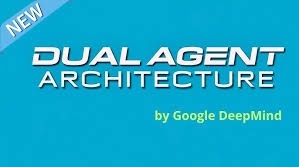
Introduction:
This article discusses Google DeepMind’s new dual-agent architecture for AI, which separates the system into two components: a Talker agent for fast, intuitive conversation, and a Reasoner agent for slower, deliberative thinking. Inspired by Daniel Kahneman’s concept of “Thinking Fast and Slow,” this approach aims to address challenges in AI systems by simulating human-like cognitive processes.
The dual-agent architecture proposed by Google DeepMind is a significant advancement in the field of artificial intelligence. By dividing the system into two distinct components, the Talker and Reasoner, DeepMind aims to address some of the inherent limitations of traditional AI models.
Talker agent:
- Fast and intuitive: The Talker agent is designed to engage in rapid, natural-sounding conversations. It leverages techniques like neural networks and reinforcement learning to learn from vast amounts of text data and generate responses that are coherent, informative, and engaging.
- Human-like conversation: By mimicking human conversation patterns, the Talker agent can create a more immersive and interactive experience for users.
- Real-time interactions: The Talker agent’s speed allows it to handle real-time conversations, making it suitable for applications like chatbots and virtual assistants.
Reasoner agent:
- Slower and deliberative: In contrast to the Talker agent, the Reasoner agent is focused on deeper, more thoughtful reasoning. It employs techniques like symbolic reasoning and knowledge graphs to process complex information and arrive at informed decisions.
- Complex tasks: The Reasoner agent is well-suited for tasks that require careful consideration, such as problem-solving, planning, and decision-making.
- Complementary to the Talker: The Reasoner agent can provide the Talker with valuable insights and guidance, helping it to generate more accurate and relevant responses.
Benefits of the dual-agent architecture:
- Improved performance: By combining the strengths of both agents, the dual-agent architecture can achieve better overall performance than traditional AI models.
- Enhanced flexibility: The ability to switch between the Talker and Reasoner agents allows the system to adapt to different situations and tasks.
- More human-like behavior: The dual-agent architecture can produce more natural and engaging interactions with users.
Potential applications:
- Customer service: The dual-agent architecture can be used to create chatbots that can provide personalized assistance to customers.
- Education: The system can be employed to develop intelligent tutoring systems that can adapt to the individual needs of students.
- Healthcare: The dual-agent architecture can be used to create virtual health assistants that can provide medical advice and support.
Video discuss about Google Dual Agent Architecture:
Related Sections:
- Agent Architecture:
- Talker Agent: Handles fast, intuitive conversations with humans
- Reasoner Agent: Manages slow, deliberative reasoning and planning
- Shared Memory: Allows both agents to access and update information
- Implementation Details:
- Uses chain-of-thought prompting and the REACT framework
- Employs partially observable Markov decision processes (POMDPs)
- Utilizes in-context learning and reinforcement learning
- Key Components:
- Belief State: Structured objects storing the agent’s understanding of user goals and context
- Action Space: Includes sorts (reasoning traces), tool usage, belief updates, and conversational responses
- Memory Integration: Long-term storage of belief states and interaction history
- Learning and Optimization:
- Reinforcement learning framework for policy optimization
- In-context learning for providing relevant information to the agents
- Continuous updating of belief states based on user interactions
Conclusion and Key Takeaways:
In conclusion, Google DeepMind’s dual-agent architecture represents a promising new direction in AI research. By separating the system into two distinct components, DeepMind has created a more flexible, powerful, and human-like AI model that has the potential to revolutionize a wide range of industries.
Google’s innovative dual-agent AI architecture is a major step forward in developing highly efficient and human-like AI systems. By segregating quick, instinctive responses from slower, thoughtful reasoning, the system may offer more authentic interactions while still handling intricate problem-solving tasks effectively. Utilizing shared memory and consistently updating belief states enables adaptive and contextually aware responses.
Key points:
- Separation of fast (Talker) and slow (Reasoner) thinking processes in AI
- Use of shared memory for seamless integration between agents
- Implementation of reinforcement learning and in-context learning for optimization
- Potential for future improvements, including multiple specialized Reasoner agents
This discussion suggests that adopting this strategy could result in more streamlined AI systems, using smaller and cost-effective models for basic tasks and reserving larger models for complex reasoning as needed.



It’s amazing to go to see this web page and reading the views of all friends about this article, while I am
also zealous of getting experience.
Thank you. Your positive feedback motivates me to continue doing what I do.